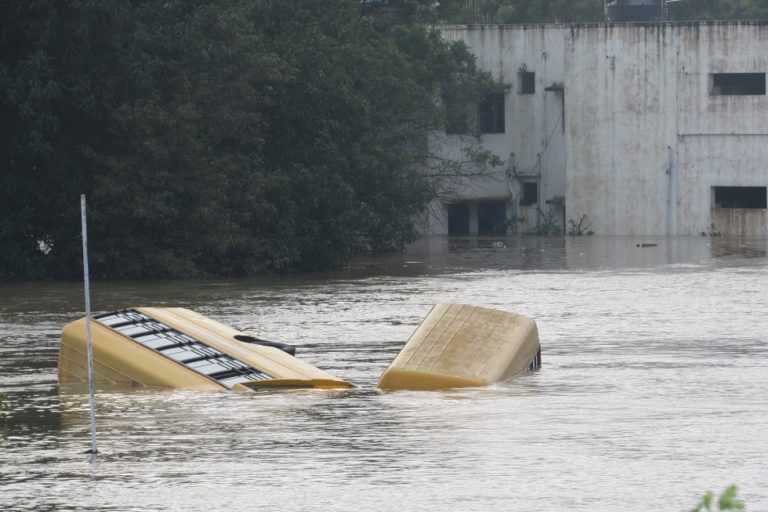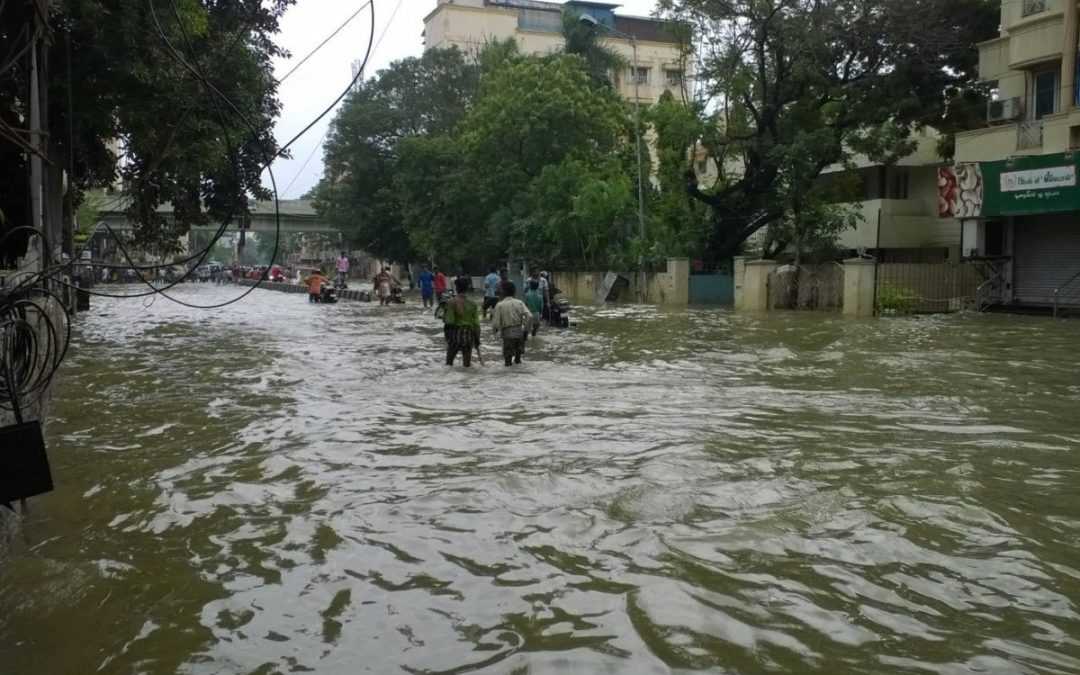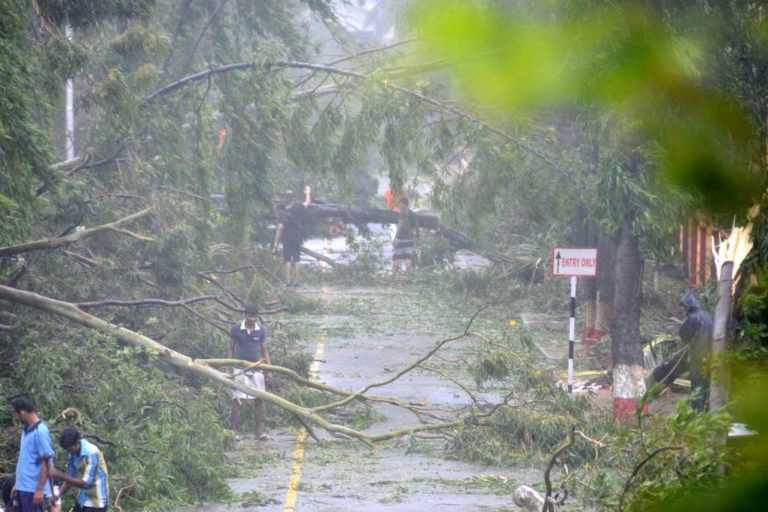
Climate change increases India’s vulnerability to extreme weather events: Report
- India is all set to submit the second biennial update report (BUR) to the United Nations Framework Convention on Climate Change (UNFCCC) which takes stock of India’s action to tackle climate change and notes that India is on track to achieve the major milestones promised.
- The first BUR report was submitted in December 2015. The draft of the second BUR reveals that over 5,800 people and thousands of animals died across India during 2014-17 due to extreme weather events whose frequency is rising due to climate change.
- The draft report enumerates impact of climate change on pattern of India’s rainfall, and temperature while expressing concerns about India’s climate-sensitive sectors like agriculture and forestry for livelihood.
In just four years, over 5,800 people and thousands of animals in India have lost their lives to “extremes of temperature, rainfall and tropical cyclones.” Increase in frequency and intensity of such disasters related to climate change impacts on the weather systems is a serious concern, notes the draft of India’s report to United Nations Framework Convention on Climate Change (UNFCCC).
A final version of the report, ‘Second biennial update report (BUR) to the UNFCCC’, which is to be submitted during the ongoing 24th meeting of the Conference of Parties (COP-24) to the UNFCCC at Katowice, Poland. The meeting from December 2-14 is significant as it is expected to finalise the guidelines for implementation of the Paris Climate Agreement. At Paris Agreement in 2015, the world agreed to aim to limit the rise in global average temperature to well below two degree Celsius above pre-industrial levels and pursue efforts to limit the temperature increase to 1.5 degree Celsius above pre-industrial levels.
India’s 17-member delegation to CoP 24 is led by environment minister Harsh Vardhan, said that India expects that COP-24 should be able to frame guidelines, which are pragmatic and gives due consideration to challenges and priorities of developing countries inter alia different starting points as compared to developed countries, their vulnerabilities, development priorities like eradication of poverty, food security, energy access and providing health infrastructure.
“COP-24 should give equal focus to all agenda items, and the outcome of COP-24 should be balanced, inclusive, comprehensive and consistent with the principles and provisions of Convention and its Paris Agreement” said Harsh Vardhan.
India has over 17.6 percent of the world’s population living on 2.4 percent of the world’s geographical area. India is one of the most vulnerable countries to climate change and the report is significant as about 49 percent of the population depends on agriculture and other climate-sensitive livelihood activities.
The report presents an overall look at the threats that India’s weather systems, ecological dynamics and natural resources already faces from climate change, the impacts that it is already having, update on India’s greenhouse gas emissions and efforts for climate change adaptation and mitigation like India’s massive renewable power programme. It also expresses concerns about the international finance required by India to effectively tackle climate change.
Last month, the draft report BUR was first reported by Business Standard newspaper which emphasised that India is well on the trajectory to achieve two of its three major commitments under the Paris Agreement. It stressed that India is on its way to achieving the commitment regarding reduction in the greenhouse gas emission intensity by 33-35 percent below 2005 levels by 2030 and having 40 percent of its power capacity from non-fossil fuel resources. But where it is falling short, for now, is the promise of an additional carbon sink of 2.5 to 3 billion tonnes of carbon dioxide equivalent through additional forest and tree cover by 2030.
The draft report notes that India has witnessed, “many instances of extremes of temperature, rainfall and tropical cyclones in recent years.”
As per the data about the ‘weather extremes in India (during 2014-2017)’, over 5,800 people and 10,000 cattle died due to extreme weather events like cold wave, heat wave, heavy rainfall resulting in floods, hailstorm, lightning and cyclonic storms. Of these, at least 3,650 were due to heat waves and cold waves alone.
For the period 1961-2013, the frequency, total duration of heat waves per season and maximum duration of heat waves increased over India during the summer season, revealed the draft while adding that the duration of heat waves over central and north-west India has gone up by about five days over the past 50 years.
“The frequency of occurrence of hot days during the pre-monsoon season shows a significant increase over the east and west coasts of India and interior peninsula. Likewise, an increasing trend in the frequency of hot nights is seen in the east coast, west coast and north-west India. The frequency and duration of heat waves over north-west India and east coast of India have also increased,”said the report.

Urban flooding due to high intensity rainfall events has become a common occurrence in India. Photo by Destination8infinity/Wikimedia Commons.
Impact of climate change: Rainfall variation and higher temperature
The draft report states that an analysis of rainfall data from the India Meteorological Department (IMD) observational network for the period 1901-2010 revealed, “increasing trends in the frequency of dry days in most parts of the country during winter, pre-monsoon and southwest monsoon seasons.”
It observed that “although there is inter-annual variability, the rainfall during Indian summer monsoon has largely remained stable over the last century” and the rainfall data from IMD’s observational network shows the all-India annual and monsoon rainfall for the 1901-2015 period does not show any significant trend.
But it noted that IMD’s data reveals that the average monsoon season rainfall has increased over states like Bihar, Gujarat, Jharkhand, Karnataka, Lakshadweep, Meghalaya, Mizoram and West Bengal during 1951-2010.
However, a decreasing trend in monsoon rainfall have been observed over Andaman and Nicobar Islands, Andhra Pradesh, Arunachal Pradesh, Assam, Chhattisgarh, Delhi, Goa, Haryana, Himachal Pradesh, Jammu and Kashmir, Kerala, Madhya Pradesh, Maharashtra, Manipur, Nagaland, Orissa, Punjab, Rajasthan, Sikkim, Tamil Nadu, Tripura, Uttar Pradesh and Uttarakhand.
It underlined that extreme hazardous weather events are resulting in enhanced exposure to multi-hazard vulnerability with adverse impact on ecosystems, natural resources, agriculture and socio-economic profile.
The draft also highlighted that an analysis of one-day extreme rainfall series (rainfall exceeding 15 centimetres per 24 hours) has shown that the intensity of extreme rainfall has increased over coastal Andhra Pradesh and adjoining areas, Saurashtra and Kutch, Orissa, West Bengal, parts of northeast India, and eastern Rajasthan while there is a significant decrease observed both in intensity and frequency of extreme rainfall over Chhattisgarh, Jharkhand and some parts of northern India.
It noted that the frequency of very light rain and light to moderate rain events has decreased significantly over most of the states while there are significant increasing trends in very heavy to extremely heavy rainfall events over most parts of the country.
In the large regions of the country – 17 sub-divisions out of 36 – increasing trends in the frequency of heavy rainfall events dominated during the period 1901- 2011, said the report while adding that in the recent period (1951-2011), increasing trends in the frequency of heavy rainfall were noted in eleven subdivisions.
The draft report observed that there is a significant increasing trend in the frequency of rainstorms in last 65 years (1951-2015) and the duration of rainstorms have also shown an increase of about 15 days during the period 1951-2015. The report stated that these rainstorms are responsible for causing large-scale floods over the country.
The flood risk has also increased significantly over India. The draft report notes that the “urban flooding is being experienced with an increasing frequency due to insufficient drainage to carry higher runoff caused by heavy/ high-intensity rainfall, which increases the flood peaks”.
The draft report emphasised that the sea level has also been rising making the coastal populations and their livelihoods vulnerable stating that “analysis over 1993–2012 period reveals that the rate of sea-level rise is close to global mean sea-level-rise trend.”
The draft BUR also said that in conformity with the rising trend observed in global surface temperatures (0.85±0.18 degree Celsius) since 1901, the annual mean temperature for the period 1901-2015 over India has also shown a significant increasing trend of 0.66 degree Celsius per hundred years.
“This rise is mainly contributed by the rise in the maximum (day) temperatures. However, the rate of rise in the annual mean temperature is much higher since the 1980s, mainly due to a sharp rise in the minimum temperatures. For the 1981-2017 period, the mean, maximum and minimum temperatures increased almost at an equal rate of around 0.2 degree Celsius per decade, which is much higher than the trends for the period 1901-2017,” added the draft report.
Explaining further, the draft report states that on a seasonal scale, the highest increasing trend in the mean temperature was observed in the post-monsoon and winter seasons.
“Rise of maximum and minimum temperatures, during the past 30 years, is mostly confined to the northern, central and eastern/ north-eastern parts of the country. Spatial warming trends obtained from mean annual temperature anomalies based on the data for the period 1901-2017 suggests significant positive (increasing) trend over most parts of the country except in parts of some states that include Rajasthan, Gujarat and Bihar, where significant negative (decreasing) trend was observed,” it added.
India has roughly four percent of the world’s fresh water resources and the draft report states that overall impact of climate change on water resources is anticipated in terms of the rise in extremes, thereby increasing the flood and drought frequency, and reducing natural groundwater recharge.
“Alterations in the flow of the largest river system in India, Ganga-Brahmaputra-Meghna system, could significantly impact irrigation, affecting the amount of food that can be produced in their basins as well as the livelihoods of millions of people,” it warned.
Experts agreed with report and stated that India now needs to take a leadership role.
“The report reiterates all the scientific findings which clearly shows that extreme weather events are now impacting the agriculture sectors as well as urban areas. In fact, urban areas like Mumbai or Chennai are now getting hugely impacted by extreme rainfall events. From agriculture to urban infrastructure is getting impacted by extreme weather events. Deaths due to impact of heat waves are increasing in urban areas. The losses could be in billions of dollars every year. It shows climate change is now hitting India hard, ” said Chandra Bhushan, who is CSE’s deputy director general and head of climate change unit.
“India needs to now take a leadership position on climate change so that we are able to contain warning (about rise in global temperature) within manageable limits,” said Bhushan.

India has an ambitious target of creating a huge carbon sink through developing an additional forest and tree cover by 2030. Photo by Mayank Aggarwal/Mongabay-India.
Climate and forests are intrinsically linked
The draft of India’s second biennial update report notes that the forests react sensitively to a changing climate as “climate and forest are intrinsically linked”.
The total carbon stock in the forests for 2017 has been estimated to be 7,083 million tonnes. The annual increase of carbon stock is 19.50 million tonnes which is 71.5 million tonnes of CO2 equivalent.
In its intended nationally determined contributions (INDCs) submitted to UNFCCC in 2015, India had pledged to create an additional carbon sink of 2.5 to 3 billion tonnes of CO2 equivalent through additional forest and tree cover by 2030.
According to India’s India State of Forest Report (ISFR) 2017 released by India’s Ministry of Environment, Forest and Climate Change (MoEFCC), the country’s total forest and tree cover is 802,088 square kilometre which is about 24.39 percent of the country’s total geographical area.
Of that, 708,273 square km. (21.54 percent of the total geographical area) is tree cover and 93,815 square km (2.85 percent of the total GA). India’s target is to have about 33 percent of its geographical area under forest cover.
Impact on agriculture
Dependency of a significant section of India’s population on climate-sensitive sectors such as agriculture and forestry for livelihood is also a cause of concern.
“Any adverse impact on water availability due to the recession of glaciers, decrease in rainfall and increased flooding in certain pockets would threaten food security, cause die back of natural ecosystems housing species that sustain the livelihoods of rural households, and adversely impact the coastal system due to sea level rise as well as increased frequency of extreme events,” the report said.
On agriculture sector, the draft report notes that in the last four years, the level of real agricultural GDP and real agriculture revenues has remained constant, owing in part to weak monsoons in two of those years. “Climate change—whose imprint on Indian agriculture is already visible—might reduce farm incomes by up to 20-25 percent in the medium term,” it stressed.
India had submitted the first BUR in December 2015 which had revealed that a reduction of emission intensity of GDP by about 12 percent between 2005 and 2010 has been achieved against India’s voluntary pledge to reduce the emission intensity of its GDP by 20–25 per cent by 2020, compared with the 2005 level.

